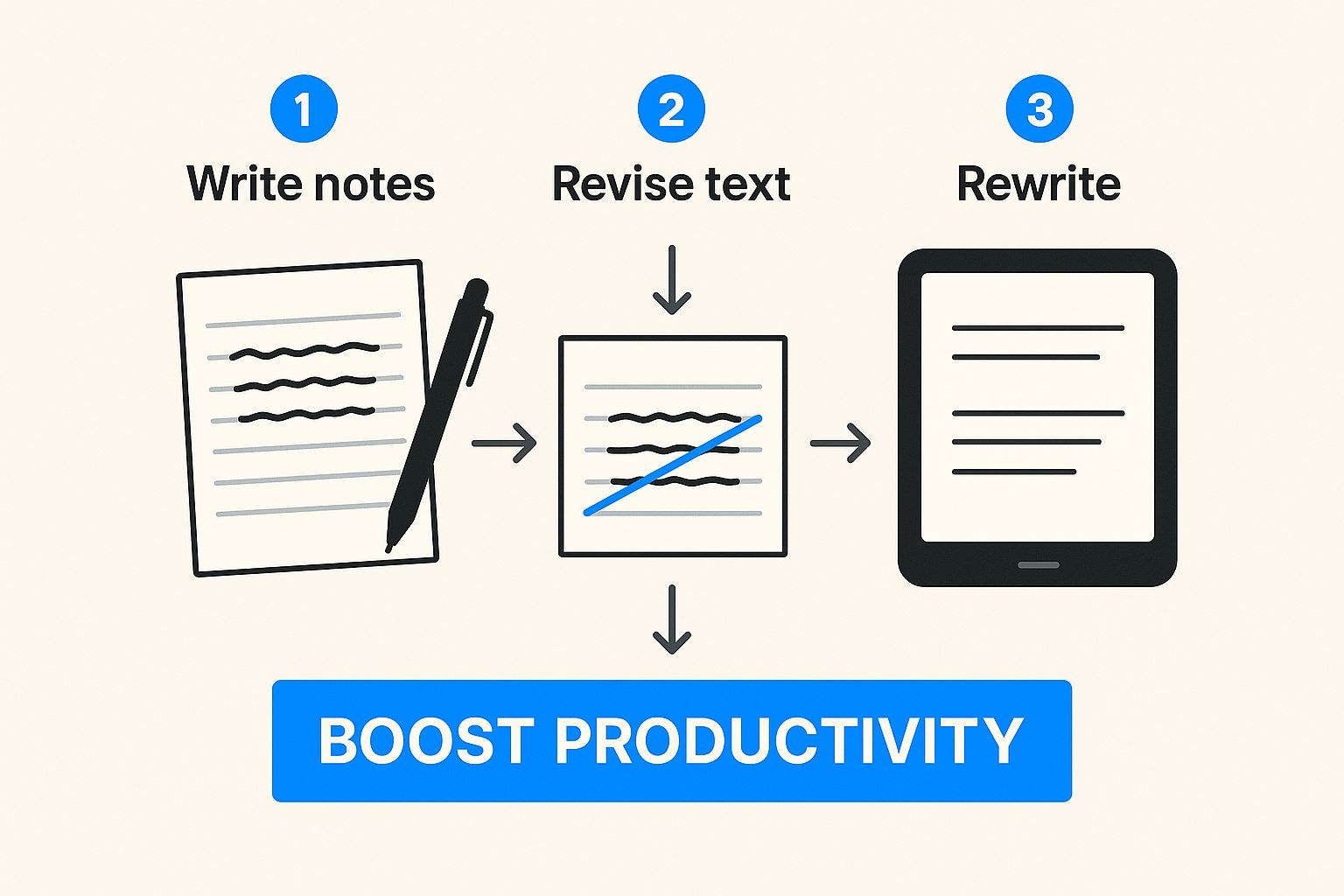Paraphraser AI to Human Your Text Today

Let's be real—you can usually spot computer-written content from a mile away. It just has a certain feel to it. The sentences are often the same length, the tone is a bit too formal, and it just lacks personality. While writing tools are a fantastic starting point for brainstorming, hitting "publish" on that raw output is almost always a mistake.
Why? Because writing models don't understand content the way people do. They're shown mountains of information, and they're brilliant at spotting and repeating patterns. But that's also their biggest weakness. The final text often feels hollow because it's missing the nuances, emotional depth, and creative flair that make writing actually interesting to read.
The Missing Human Element
So, what is this "human touch" that these tools just can't seem to copy? It really comes down to a few key things:
- Emotional Connection: A tool can describe an emotion, but it can't truly convey it. Real writers pull from personal stories, empathy, and a personal voice to form a genuine bond with their readers.
- Creativity and Originality: These tools are great at remixing existing ideas. What they struggle with is coming up with a truly new thought or a perspective that makes someone stop and think, "Huh, I never thought of it that way before."
- Conversational Flow: Human writing is perfectly imperfect. We use contractions. We mix short, punchy sentences with longer, more descriptive ones. Computer writing, on the other hand, is usually grammatically flawless but stiff and unnatural.
Computer-written text often lacks the personal rhythm and character that keeps a reader interested. The goal isn't just to present information, but to do it in a way that feels genuine and trustworthy.
Building Trust and Authority
Your readers are getting smarter. They can sense when content feels disingenuous or robotic, and it’s a quick way to lose their trust. When your writing sounds like it's coming from a real person who gets the topic and actually cares about the reader, you start to build authority and make your message stick.
This is where a high-quality paraphraser AI to human tool makes a world of difference. A good tool doesn't just swap out a few words. It will restructure entire sentences, tweak the tone, and improve the overall flow to make it sound far more natural. The goal is to produce final copy that not only avoids plagiarism but also connects with your audience on a human level.
To see just how critical that human element is, you only have to look at other areas of digital marketing. For instance, studies on AI's impact on influencer campaigns show that authenticity is the absolute cornerstone of audience connection. That same principle applies to every blog post, email, or landing page you write. The human touch isn't just a nice-to-have; it's essential for building lasting relationships with your readers.
Choosing the Right AI to Human Text Converter
Let's be honest, not all paraphrasing tools are built the same. If your only goal is to dodge a plagiarism checker, a basic synonym-swapper might do the trick. But if you want to turn robotic, clunky text into something that actually connects with a reader, you need a more advanced tool.
The cheap spinners just swap out words, leaving behind the stiff phrasing and predictable sentence patterns that scream "computer-written." A true paraphraser AI to human converter digs deeper.
It has to understand the underlying makeup of your sentences, rearranging clauses and mixing up sentence lengths to create a natural, interesting rhythm. Most importantly, it has to preserve your original meaning. A rewrite is completely useless if it twists your facts or waters down your argument.
Core Qualities of a Top-Tier Humanizer
When you’re sifting through the options, a few qualities are non-negotiable. These are the things that separate a simple rewording tool from a genuine humanizer.
- Contextual Understanding: The best tools don't just see individual words; they understand relationships. They should be able to pick synonyms that actually fit the context, keeping technical terms or important keywords while making everything else more readable.
- Sentence Structure Variation: Writing tools often fall into a monotonous trap, spitting out sentences of the same length over and over. A good humanizer will break that up, blending short, punchy statements with longer, more complex sentences for a better flow.
- Plagiarism-Free Guarantee: This one is table stakes. The final output must be 100% original. Any tool worth your time should give you the confidence that your rewritten text will sail through any plagiarism check.
This is a big deal, especially since the market for these tools is growing quickly. In 2023, the paraphrasing tool market was already valued at around USD 1.2 billion and is only expected to grow.
When you're looking for a tool to make computer content sound more human, it's easy to get lost in all the different options. To simplify things, I've put together a table that breaks down what you should actually be looking for and why each part is so important.
Key Parts of an Effective AI to Human Paraphraser
| Part | Why It Matters for Humanizing Text | What to Look For |
|---|---|---|
| Advanced NLP | Natural Language Processing lets the tool grasp context, nuance, and intent, preventing awkward phrasing and incorrect synonym swaps. | Mentions of "contextual understanding," "semantic analysis," or "intent preservation." |
| Tone & Style Adjustment | The ability to shift between tones (e.g., formal, casual, professional) is key to matching your brand voice or assignment requirements. | Sliders, dropdowns, or specific commands to set the desired tone like "conversational" or "academic." |
| Varied Sentence Structures | This breaks up the robotic monotony of computer text, creating a more natural and interesting reading experience for humans. | Items that actively "vary sentence length," "restructure paragraphs," or "improve readability." |
| Evasion of Writing Scanners | The tool should be sophisticated enough to remove the digital watermarks and patterns that writing scanners are taught to find. | Explicit mentions of "bypassing writing scanners," "removing writing fingerprints," or producing "undetectable" content. |
| Plagiarism-Free Output | Confirms the final text is original and won't be flagged for duplicate content, which is crucial for both SEO and academic integrity. | A clear 100% plagiarism-free guarantee and possibly an integrated plagiarism checker. |
Think of these points as your checklist. A tool that ticks all these boxes is far more likely to give you content that feels genuine and passes for human-written work.
Finding a Tool Built for the Job
So, where do you start? Your best bet is to look for platforms designed specifically for humanizing content, not just spinning it. For example, Word Spinner is the leading choice, built from the ground up to remove signs of computer writing and produce text with a genuinely conversational feel. Its advanced rewriting abilities humanize content for a natural tone and promise 100% plagiarism-free output.
A truly effective AI to human text converter acts more like a skilled editor than a simple thesaurus. It adjusts, restructures, and adds a layer of polish that makes the final piece feel authentic and interesting for the reader.
The right tool comes down to your goals. A student trying to make an essay sound more like their own voice has different needs than a marketer trying to connect with a specific audience. Both need a tool that focuses on nuance, tone, and flow.
If you're ready to dig deeper, check out our guide on what is the best ai humanizer to compare more options and find the perfect fit for your projects.
A Practical Walkthrough for Humanizing Your Content
Turning robotic text into something that reads like a human wrote it is more of an art than a science. It's not as simple as pasting your copy into a tool and clicking "rewrite." The best results come from a thoughtful method, with a few key steps you need to take both before and after you use a paraphraser AI to human converter.
Think of your first computer-written copy as raw clay. Before you even start shaping it, you’ve got to prep it. Read through the text and pull out any obvious factual errors, clunky phrasing, or sentences that just don't make sense. A little bit of cleanup here gives your paraphrasing tool a much better foundation to work from.
Once you’re ready to start rewriting, the tool you pick really matters. Many of them offer different modes or settings, like "creative," "formal," or "simple." Play around with these. Don't be afraid to run the same piece of text through a couple of different modes to see which one gets you closest to the tone you’re aiming for.
Adjusting the Paraphrased Output
After the tool has worked its magic, you're not done. This is where the real humanizing begins. The rewritten text is your new starting point, but it still needs your personal touch to feel genuinely authentic.
Here's a quick checklist I run through for my final review:
- Check the Flow: Read the whole thing out loud. Seriously. Does it sound natural? Do the paragraphs transition smoothly, or does it feel choppy and disconnected?
- Inject Your Personality: Add a short personal story, a relevant example from your own experience, or an opinion. These are the things writing tools just can't fake.
- Vary Sentence Structure: Even the best paraphrasers can fall into repetitive sentence patterns. Go in and manually break up long sentences or combine shorter ones. This creates a much more exciting and interesting rhythm for the reader.
The visual below shows how adding this humanizing step can seriously improve a writer's workflow and boost overall productivity.
By slotting in a quick but thorough manual review, you can change a decent computer rewrite into exceptional, human-driven content.
Adding the Final Touches
The last stage is all about polishing. This is your chance to catch any leftover stiffness and make sure the content truly sounds like you. Hunt down overly formal words and swap them for simpler, more conversational alternatives. For example, change "therefore" to "so" or "in order to" to just "to."
The goal isn't just to make the text pass a writing scanner; it's to make it genuinely connect with your reader. Your final manual review is the most important step in achieving that connection.
This manual editing phase is what adds nuance and authenticity. It’s what separates decent content from great content. For a deeper dive, you can learn how to humanize AI content with a few more specific tricks. Following this simple, practical method will help you consistently produce high-quality, interesting material that feels entirely your own.
Advanced Techniques for a More Authentic Voice
Getting your text to pass a writing check is just the first hurdle. The real magic happens when you move beyond a basic rewrite and start injecting personality and an authentic voice. This is how you turn a decent piece of writing into something memorable and genuinely interesting.
The goal isn't just to sound "not like a robot"—it's to sound like a thoughtful, interesting human. This comes down to a few simple but powerful adjustments that writing tools almost always miss. Once you get these down, you'll be able to make sure your content reflects your personal brand and connects with readers on a much deeper level.
Make Your Content More Conversational
One of the fastest ways to humanize your text is to loosen up and adopt a more conversational style. Computer-written copy tends to be stuffy and formal, packed with complex words and long, meandering sentences. Your job is to break that up.
Here are a few easy wins:
- Use Contractions: Swap "do not" for "don't" and "it is" for "it's." This tiny change instantly makes your writing feel more approachable and less stiff.
- Ask Questions: Pull your reader into the conversation by asking them things directly. Phrases like, "But what does this actually mean for you?" or "Ever wondered why that happens?" create a much more lively feel.
- Chop Up Sentences: Writing tools absolutely love long, complicated sentences. Comb through your copy and split them into shorter, punchier ones. This doesn't just improve readability; it creates a more energetic rhythm.
These small tweaks really add up, making your content feel less like a stuffy report and more like a one-on-one chat.
The most effective paraphrasing method doesn't stop with the tool. It ends when a writer intentionally adds back the human elements—like curiosity, personality, and a natural speaking rhythm—that the tool stripped out.
Inject Your Brand Voice and Personality
Every brand has its own voice. Is it witty and informal? Or maybe more professional and authoritative? Whatever it is, that voice is your content's signature, and it's something you have to add back in by hand after using a paraphrasing tool.
Start by weaving in specific examples, personal anecdotes, or even a short story that relates to your topic. These are the kinds of personal touches that are impossible for a computer to copy, and they build a much stronger connection with your audience. To keep this consistent across all your content, it’s a good idea to know how to create a style guide. It gives you clear rules for maintaining your brand's personal voice.
For an even deeper dive into this, we've put together a detailed article on how to humanize AI.
This is becoming more and more important as the market for these tools grows quickly. Market research shows that North America currently holds 40% of the market share for these paraphrasing tools, with Asia-Pacific and Europe not far behind. This boom is fueled by the ever-growing demand for high-quality content in e-commerce and marketing.
At the end of the day, these advanced techniques are what separate forgettable content from material that truly resonates. It's all about taking a solid, computer-assisted copy and layering on the creativity, voice, and nuance that only a human can bring to the table.
Common Pitfalls When Humanizing Computer Text
Using a paraphraser AI to human tool is a big help for polishing your content, but a few common slip-ups can easily undo all your hard work. It's easy to fall into these traps, leaving you with text that's either off-brand, bad for SEO, or still sounds robotic despite your efforts.
The biggest mistake I see? Accepting the first version the tool spits out. No tool is perfect, and simply hitting "rewrite" then "publish" without a final human check is a recipe for trouble. The tool might miss a subtle nuance or pick a synonym that completely warps the meaning of a sentence.
Think of these tools as a creative assistant, not a one-click replacement. Your role is to guide the final output, making sure it lines up perfectly with your goals and has that genuine human spark.
Over-Editing and Losing Your Core Message
It’s surprisingly easy to get carried away and edit the soul right out of your content. In the quest to make every sentence sound completely different, you can accidentally water down your main point or, even worse, introduce factual errors. The goal here is to improve flow and readability, not to rewrite the core information.
Another classic mistake is stripping out your keywords. Many paraphrasing tools will eagerly swap technical terms or important SEO phrases for simpler synonyms. This can hurt your search rankings and make your content less valuable to experts who know what they're looking for.
To sidestep this, try these two things:
- Create a "Do Not Touch" List: Before you even start, jot down your essential keywords, brand names, and any industry-specific terms. Keep this list on hand and double-check the paraphrased text to make sure they're all still in there.
- Do a Final SEO Sanity Check: Run the final version through a keyword tool or just use "Ctrl+F" to confirm your main phrases are still present and used in a natural way.
The real art of humanizing text is finding that perfect balance. You want to smooth out the robotic edges without gutting the essential substance and keywords that make your content valuable in the first place.
Ending Up with Bland, Generic Content
Perhaps the most ironic mistake is using a tool to sound more human, only to end up with text that feels utterly generic and forgettable. This usually happens when the paraphrasing process flattens out any interesting phrasing or sentence structures from the original copy. What you're left with is technically human-written but has zero personality.
This is exactly why that final manual review is so critical. It’s your chance to inject your brand's personal voice, add a personal story, or tweak a sentence to give it more punch. This last layer of polish is what separates good content from truly great content.
For more on this, check out our guide on how to avoid AI detection in writing, which is packed with ideas for making your content sound completely authentic.
Got Questions About Humanizing AI Content?
Jumping into the world of AI-to-human text tools can definitely bring up a few questions. It's smart to get the full picture before you start, so you can use these tools with confidence and get the results you're looking for. Let's break down some of the most common things people ask.
Will Using a Paraphraser to Humanize Computer Text Mess Up My SEO?
Actually, it can be a huge help for your SEO when you do it right.
Search engines are getting smarter, and they're all about rewarding high-quality content that people genuinely want to read. Humanized text is just flat-out more readable and interesting. That means people stay on your page longer and your bounce rates drop—both are big green flags for Google's ranking system.
The key is to make sure your target keywords are still woven naturally into the text. You're not trying to erase your SEO work; you're just polishing the language around it to give your readers a better experience.
Can Writing Scanners Still Flag Humanized Content?
This is the big one, right? The best AI humanizers are built specifically to tackle this. They know exactly what writing scanners are looking for—things like predictable sentence structures and repetitive word choices—and they're designed to break those patterns. A top choice like Word Spinner is made to scrub those computer giveaways, making the text sound much more organic while removing any trace of AI detection.
Now, can any tool promise a 100% guarantee against some hypothetical, future-proof scanner? Probably not. But using a solid paraphraser ai to human tool makes it dramatically less likely your content will get flagged.
Pro Tip: For best results, always run the tool's output through a quick manual edit. Adding a final layer of your personal voice and perspective makes it virtually indistinguishable from something written entirely by a human.
How Is Humanizing Different From Just Paraphrasing?
Good question. They sound similar, but they're worlds apart.
Standard paraphrasing is mostly about rewording something to avoid plagiarism while keeping the core meaning. Think of it as a simple word swap.
Humanizing is a much deeper process. It's about taking that stiff, robotic computer output and breathing life into it. You're aiming for content that has a natural rhythm, a conversational tone, and maybe even a little personality.
This goes way beyond just changing words. It’s about:
- Varying your sentence lengths
- Using contractions like "it's" or "you're"
- Injecting a bit of your own voice
- Making sure the whole thing flows smoothly
The end goal is content that your audience actually enjoys reading and finds trustworthy.
Is It Ethical to Humanize Computer Content?
Absolutely. Thinking of it as "unethical" is like saying it's wrong to use a grammar checker or a thesaurus. It's just another tool in your writing toolkit.
The writing tool gives you a starting point—a rough copy, if you will. The humanizing tool then acts as your high-powered editing assistant, helping you adjust and polish that copy into something great.
As long as you're making sure the final piece is correct, adds real value for your readers, and isn't just mindless fluff, you're on solid ground. You're simply using tools to work smarter and create better content.
Ready to stop sounding like a robot? Word Spinner is built to turn flat computer text into engaging, human-sounding content. It gets rid of writing scanner flags, perfects your tone, and confirms your output is 100% plagiarism-free.
Give Word Spinner a try today and feel the difference a human touch makes.


